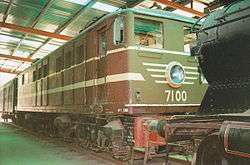New South Wales 45 (later 71) class locomotive
|
7100 at Berowra in June 1962 | |||||||||||||||||||||||||||||
| |||||||||||||||||||||||||||||
| |||||||||||||||||||||||||||||
| |||||||||||||||||||||||||||||
| |||||||||||||||||||||||||||||
The 45 class was a class of mainline electric locomotive built in-house in 1952 by the New South Wales Government Railways' Chullora Railway Workshops. With only a single locomotive in the class, 4501 was renumbered 7100 in October 1961 freeing up the number range for the 45 class diesel locomotives.
Construction

The sole member of the class was designed by the New South Wales Government Railways and was built at their Chullora Railway Workshops using components supplied by Commonwealth Engineering. It was completed in June 1952 and numbered 4501.[1]
Operation
4501 had a one-hour power rating of 2,700 horsepower (2,000 kW) with a total weight of 108 long tons (110 t). Its maximum speed was 70 miles per hour (110 km/h) It had a driving compartment at each end of its very box-shaped body. Its colour scheme being bottle green, with chrome lining, it became affectionately known as the Green Beetle.
Its purpose was to provide experience of operating powerful electric locomotives prior to the arrival of the 46 class locomotives which had been ordered from England for use on the electrified Main Western line to Bowenfels. Once the electrification project had reached Penrith in October 1955, 4501 had its first opportunity to haul passenger trains. Six months later, when the first 46-class arrived, the locomotive became a regular assistant locomotive for steam powered trains on the Main North line between North Strathfield and Hornsby.
In 1957, it was transferred to the Flemington Maintenance Depot where it was employed as a shunter. At the time, Flemington was the base for all locomotive hauled air-conditioned carriages.
In October 1961, it was re-numbered 7100. In October 1967, it received a major overhaul where several tonnes of additional ballast was added. Main-line safeworking equipment was provided to allow it to haul coal trains over the newly electrified Main South from Glenlee to Rozelle.[2]
Demise
Failures dogged the veteran locomotive and it was withdrawn in June 1974. Following an extended period of storage, it was placed at the New South Wales Rail Transport Museum moved to Thirlmere.[3] In April 2009 it was relocated to the former Broadmeadow Locomotive Depot. It is now on RailCorp's heritage list.[4]
References
- ↑ A Century Plus of Locomotives. Australian Railway Historical Society, New South Wales Division. 1965.
- ↑ "20 Years Ago" Railway Digest August 1987 page 259
- ↑ Oberg, Leon (2007), Locomotives of Australia, 1854 to 2007 (4th ed.), Rosenberg Publishing, pp. 260–261, ISBN 978-1-877058-54-7
- ↑ "Locomotive, Electric 7100". New South Wales Department of Environment & Heritage.
Further reading
- New South Wales Rail System Locomotives. Sydney: Archives Section, State Rail Authority of New South Wales. 1984.
